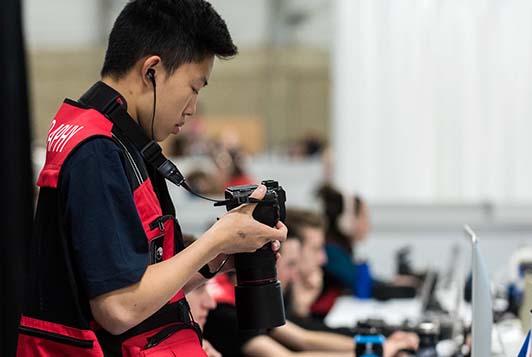3D/2D Character Computer Animation
What is 2D-3D Character Computer Animation?
Computer animators use software such as 3D Studio Max, Maya, or Adobe Animate to produce animation for film, television and video. Specific examples of their creative work ranges from video games, television shows, computer simulations and educational modules to special effects for movies, websites and advertising.
As in all productions of this kind, a substantial amount of preparation takes place before the actual animation work begins. Working with the director, the animator plans and develops the story behind the animation, model characters, the background scenes, the arrangement of models in a scene, the use and placement of lighting and motion cameras and the interaction between objects. This pre-production work also includes developing storyboards, layout and character designs, and when it is finished the animator begins to create, refine and render the objects on their computer.
Graphic arts technicians perform some or all of the following duties:
- Review the graphic designer’s instructions
- Produce or assist in developing and producing design concepts
- Capture elements such as titles, text, drawings, illustrations, graphics, lettering, colour harmonization, etc. using a computer
- Produce computerized images and drawings
- Digitize images using peripherals and transform them using retouching systems, graphic palettes or specialized software
- Perform the layout, page make-up and placement using the conceptual mock-ups provided
- Produce proofs and camera-ready materials and prepare film and any other prepress materials
- Paint or ink individual cells of 2-D or 3-D animated drawings according to animator’s specifications using an electronic palette
- Lay out, draw or paint letters, figures, logos and designs for windows, advertisements, billboards, vehicles, books and publications using specialized software or painting equipment
- Work in an interdisciplinary environment.
HOW TO JOIN THE FIELD
A college diploma in commercial or graphic arts, computer graphics or animated design is required.
Experience or training in multimedia design at a post-secondary, college or technical institution may be required.
Creative ability and artistic talent, as demonstrated by a portfolio of work, are required.
INDIGENOUS AND REMOTE CONSIDERATIONS
Indigenous and remote communities are catching up to southern Canada when it comes to digital technology and computer skills and industries. Not all communities have access to reliable, affordable internet and service interruptions are all too common. Access to computers at home is not a given for everyone and Elders and even sometimes younger generations lack computer knowledge, although this situation is undergoing some significant changes at the moment. But even those people in Indigenous and remote communities with interest and high-level skills in computers may not have the same access to opportunities to learn about different programs and may face significant bandwidth issues, limiting their ability to learn and develop in this field. Indigenous and remote students may need qualifying courses or need to augment college learning to be successful in this field.
Although with significant improvements currently underway to internet connections in Indigenous and remote communities, careers in this field become more viable and are likely to become more so in years to come.
DISABILITY CONSIDERATIONS
Since this job may require sitting at a computer for long periods of time, people with visual disabilities may find it challenging. They may require specialized screens. Also, as it may require sitting for long periods of time, people with certain physical disabilities may struggle as well. Accommodations such as standing desks may make the work more comfortable and ergonomic. However, the fact that this work is digital in nature, may make it attractive to people with mobility disabilities, as they may be able to perform most of the work duties from the comfort of their home. People with learning disabilities may require extra support in post-secondary as well as on the job to ensure their success.
Find the right career path for you with our interactive map!
Trouvez le cheminement de carrière qui vous convient grâce à notre carte interactive!
Sample Job Titles
- Level Designer
- Character modeller
- Animator
- Rigger
- Art Director
- Generalist Artist
- Lighter and Compositor
- Texture Artist
- Environment/Background Artist
- Layout/Previsualization Artist
- Special Effects Artist
- Graphics Designer
- Motion Graphic Artist
Companies and Sectors
- Self-employed/Freelancer
- Local visual effects, animation, or video game studios
- International film, animation or video game studios
- Larger motion picture studios
- Commercial and ad firms
- Graphic Design firms
- Architectural firms

3D/2D Character Computer Animation and the Skills for Success Program
The key Skills for Success for this career path are:
- Creativity & Innovation
- Problem Solving
- Digital



